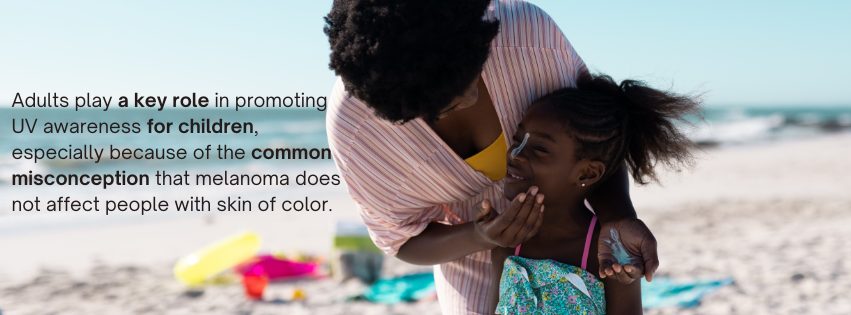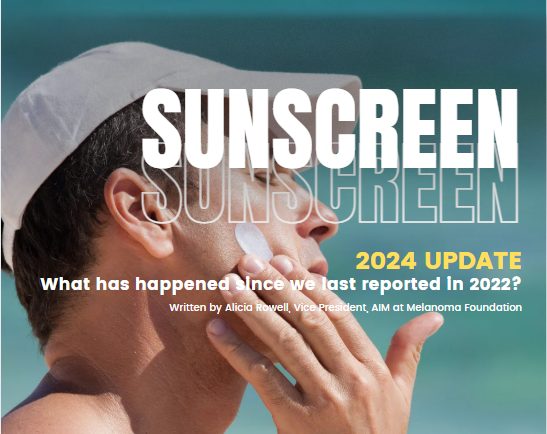Melanoma Prevention in Skin of Color

What are Some Risk Factors of Melanoma in People with Skin of Color?
Exposure to ultraviolet (UV) radiation is a major factor for the development of cutaneous (skin) melanoma. We know that people of all races, ethnicities, and complexions can sustain sunburns. We also know that people with skin of color sustain the effects of UV damage such as wrinkles, discoloration, and premature aging.
However, more research is needed to determine what other causative factors exist for melanoma among those of us with skin of color. For example, one study found that among Black patients with cutaneous melanoma, major risk factors included immunosuppression, having a personal history of cancer, or both simultaneously.1 Another study suggests mechanical stress and impact trauma initiate the development of acral lentiginous melanoma—the type of melanoma that occurs on the soles of feet, on the palms of hands, and under the finger/toenails.2

Five Things You May Not Know About Bob Marley and Acral Lentiginous Melanoma
It’s an extraordinary life story: The Jamaican-born, legendary King of Reggae died at age 36 from a disease that broadly impacts people with fair complexions, not often people of color. Unfortunately, his story wasn’t fiction. Melanoma—specifically a rare subtype called acral lentiginous melanoma—tragically ended the life of the supremely talented Bob Marley.
In addition, research has shown that melanomas from Black patients are different from the majority of patients diagnosed with melanoma. For one, tumors from Black patients lack the BRAF mutation that is observed in 50% of melanoma tumors. And two, in one study, many melanomas from Black patients diagnosed with advanced acral melanoma, mucosal/ocular melanoma, or melanoma of unknown primary were unresponsive to our most effective drug class – immunotherapy.1 These observations, coupled with the fact that the majority of melanomas in this population occur on sites not exposed to UV, indicate the biological causes for melanoma development are different. Therefore, the risk factors for melanoma development in Black individuals are likely different, too.
Cultural practices, skin types, genetics, and environmental exposures may also play a role in the development of cancers. More research is needed to understand which factors are most important for melanoma in people with skin of color. Research is also working on the biological reasons why some groups are unresponsive to certain drugs and the development of therapeutics that will address different types of disease. A better understanding of the disease will eventually aid its prevention and define risk factors.
How is Melanoma Prevented in People with Skin of Color?
Knowledgeable vigilance is your best prevention for melanoma. Early detection is your best insurance for an ideal outcome. Be informed and be aware. If you see a changing lesion or area on your skin or a wound that hasn’t healed, seek a dermatologist’s opinion about it.
For individuals who spend a lot of time in the sun, preventive measures such as sunscreen, wide-brimmed hats, protective clothing, and minimizing UV exposure at times when the UV is intense are critical for protecting your skin. Although it is true that people with darker skin tones have some natural protection against UV rays, people with skin of color still need to protect their skin.

These preventive measures are not just for adults. Minimizing UV exposure and wearing wide-brimmed hats, protective clothing, and sunscreen (for those over six months) are all important for children, too. Prevention is critical for them when they are young and unaware of the dangers UV radiation poses to their future health. Parents, grandparents and other adults can play an important role in underscoring the need for UV awareness in children, especially because of the common misconception that melanoma does not affect people with skin of color.
AIM at Melanoma and the American Academy of Dermatology recommend that all people, regardless of skin tone, follow these guidelines:
- Minimize direct sunlight when UV rays are strongest, typically between 10 am and 4 pm
- Limit your exposure to the sun by seeking shade
- Use broad-spectrum sunscreen with SPF 30 or higher
- Take measures to protect the skin of your children or other dependents
- Wear protective clothing when working or relaxing outdoors, like long sleeves and pants
- Wear a hat, and sunglasses when outdoors; if you’ll have extended exposure, consider gloves or other further protection for your skin
Sunscreen for People with Skin of Color
Sunscreen contains one or more active ingredients (UV filters) that protect the skin from exposure to UV rays. UV filters can be classified into two groups: mineral and organic.
Mineral filters—sometimes called inorganic or physical filters—work by deflecting and reflecting UV light, preventing the UV light from hitting your skin. They are effective at protecting against both UVA and UVB radiation. The two mineral filters (active ingredients) used in U.S. sunscreen are zinc oxide and titanium dioxide.
Organic filters—sometimes called chemical filters—work by absorbing UV light energy. They can protect against UVA, UVB, or both. The six organic filters (active ingredients) most commonly used in U.S. sunscreens are avobenzone, homosalate, octinoxate, octisalate, octocrylene, and oxybenzone.
Broad-spectrum sunscreen has filters that protect against both UVA and UVB rays. Most U.S. sunscreens combine two or three of the above eight filters to get the best performance.

The State of Sunscreen in the U.S.
A pivotal 2010 Australian study demonstrated that regular sunscreen use can reduce melanoma risk by 50%. However, conflicting information in the media has caused confusion around sunscreen. In this publication, we aim to clarify the current state of sunscreen in the U.S. and provide clear, evidence-based insights to help you make informed decisions for your skin’s health.
AIM at Melanoma believes the best sunscreen is the one you will use, so try different brands and formulations until you find the one you like and will wear. People with skin of color may have opted away from mineral filters in the past because some have a white residue after application; however, many mineral sunscreens are now available that better blend into your skin. Look for formulas marked “tinted.” Additionally, many clear sunscreens are now available in both mineral and chemical formulations. Some companies are specializing in designing sun protection specifically for people with skin of color so look for those formulations, too.
References
1. Wix SN, Brown AB, Heberton M et al. Clinical Features and Outcomes of Black Patients With Melanoma. JAMA Dermatol. 2024;160(3):328-333. doi: 10.1001/jamadermatol.2023.5789
2. Basurto-Lozada, P., Molina-Aguilar, C., Castaneda-Garcia, C., et al., 2021. Acral lentiginous melanoma: basic facts, biological characteristics, and research perspectives of an understudied disease. Pigment Cell Melano. Res. 34 (1), 59–71. https://doi.org/10.1111/pcmr.12885.

